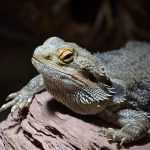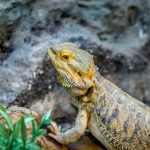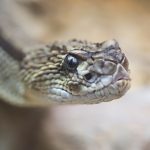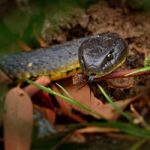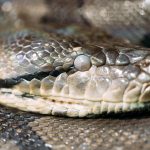Leopard geckos are fascinating reptiles and provide an enjoyable and rewarding challenge to care for. However, when constructing a natural habitat for a leopard gecko, one of the most important questions is: what substrate should you use? It is essential to select a material that meets the needs of the gecko while keeping them healthy and safe. In this article, we’ll discuss the problems with common substrates, the features of the ideal substrate, and provide solutions and tips to ensure the best environment for your leopard gecko.
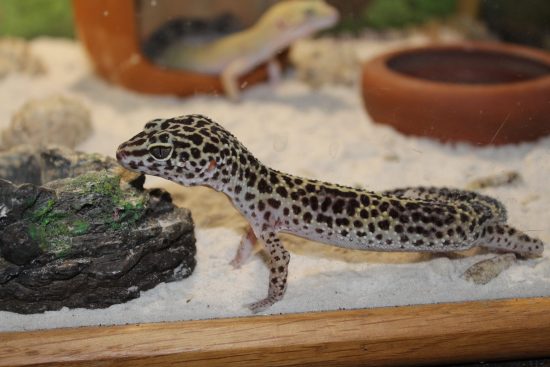
Problem with leopard gecko substrates
Leopard geckos require a wide range of substrate options to keep them healthy and happy. Choosing the wrong substrate, however, can lead to numerous problems for your leopard gecko. Some of the more common issues to look out for are the risk of impaction, skin irritation, and respiratory problems.
- Impaction is a condition where the gecko swallows a substrate particle that gets stuck in its digestive tract. The best way to prevent this is to use a substrate that is the correct size for the gecko. Sand, in particular, can be very dangerous and should only be used if your leopard gecko is large enough to safely digest it.
- Skin irritation is another common problem caused by an inappropriate substrate. This can be caused when the substrate is too coarse for the gecko’s soft skin. This can lead to abrasions and sores that can be difficult to treat. It is important to choose a substrate that is soft enough to protect the gecko’s skin.
- Respiratory problems are another issue that can be caused by the wrong substrate. Substrates such as sawdust and cedar shavings can release particles into the air that can be inhaled by your leopard gecko, leading to problems such as bronchitis and pneumonia. If you are using a more traditional substrate, such as paper towels or reptile carpet, you should make sure to clean it regularly to minimize the amount of dust and debris in the air.
When considering the right substrate for your leopard gecko, it is important to remember that safety should always be your first priority. Make sure to do your research and choose a substrate that is safe and suitable for your gecko, and you will help keep your pet healthy and happy.
Dangers of sand
When researching which substrate to choose for your leopard gecko’s home, it is important to know the dangers of sand. Sand can cause impaction in leopard geckos if ingested, leading to blockages in the digestive tract and even death. Common signs of impaction are weight loss, lethargy, refusal to eat, and diarrhea.
Sand is composed of small, jagged particles that can cause scratches and irritation in a leopard gecko’s delicate skin and respiratory system. Sand also tends to become compacted on the gecko’s body, creating a moist environment where bacteria and parasites can thrive. In addition, leopard geckos can also accidentally ingest sand while they are digging, which can cause impaction.
Due to the dangers of sand, it is important to avoid using it as a substrate. If you are looking for a natural substrate, it is best to choose a substrate made of larger particles such as pea gravel, wood chips, or coconut coir. Any substrate you choose should also be dust-free and non-toxic when ingested. It is also advisable to spot-clean the substrate regularly to prevent the accumulation of bacteria and parasites.
Overall, calcium sand is not the best choice as a substrate for leopard geckos. It can cause impaction or skin and respiratory irritation and is not as suitable for naturalistic environments. If you are looking for a naturalistic substrate, it is best to look for options made of larger particles that are dust-free and non-toxic.
Uneven surfaces
When it comes to substrate choices for a leopard gecko enclosure, there are plenty of options. One of the most important considerations is to ensure that the substrate is appropriate for the gecko and provides adequate support for their safety and comfort. One of the most popular options for providing uneven substrates is utilizing natural substrates like reptile bark, terrarium soil, and stone.
Reptile bark is great for creating an uneven substrate in the enclosure. It is an affordable substrate and comes in a variety of colors and textures. It is also easy to shape and adjust to the desired depth and topography. Reptile bark is easy to clean and provides adequate insulation for the gecko, making it a great option for the enclosure.
Terrarium soil is another natural substrate that is excellent for creating an uneven landscape in the enclosure. It is lightweight, easy to shape, and can be mixed with other substrates for more natural-looking effects. It does require more maintenance than other substrates, such as mucking out the soil every few weeks to prevent mold from forming.
Stone is a popular substrate choice for providing an uneven base for the enclosure. It is easy to shape and can be used to create walls, hills, and valleys in the enclosure. The stones should be heated in the oven first to remove any bacteria or parasites that may be present. Stone is also great for providing more drainage for the enclosure, as it helps to keep the substrate dry.
In conclusion, there are many options for creating an uneven substrate in the leopard gecko enclosure. Reptile bark, terrarium soil, and stones are all excellent choices to provide the gecko with a safe and comfortable environment. Remember to always use caution when using natural substrates to ensure they are free of parasites and bacteria.
Substrates with Poor heat and humidity retention
When selecting a substrate for your Leopard Gecko’s enclosure, it is important to consider how much heat and humidity is retained in the substrate. Poor heat and humidity retention can result in illness and even death for your Leopard Gecko. Unfortunately, many of the most commonly used substrates are not ideal for Leopard Geckos since they don’t hold onto heat and humidity well.
One of the most popular substrates used for Leopard Geckos is newspaper. Newspaper can be convenient, inexpensive, and readily available at most stores. However, the newspaper is not a good option for Leopard Geckos since it does not hold heat or humidity. This can lead to your Leopard Gecko becoming dehydrated and being deprived of the heat necessary for a healthy environment.
Pebbles and sand are also popular choices for Leopard Gecko substrates, but they also have poor heat and humidity retention as well. These substrates can also be dangerous for your gecko since they can be ingested, leading to impaction and other digestive issues.
The best substrate for Leopard Geckos is one that retains heat and humidity well. A substrate that is both absorbent and breathable is ideal. A good option for this is a mixture of coconut fiber and reptile bark. This combination of substrates is both absorbent and breathable, meaning it will retain heat and humidity well. Additionally, it is unlikely for your gecko to ingest it and cause digestive issues.
When selecting a substrate for your Leopard Gecko, it is important to consider the heat and humidity retention capabilities of the substrate. Poor heat and humidity retention can lead to serious health issues for your gecko. The best substrate for Leopard Geckos is one that is both absorbent and breathable, such as a combination of coconut fiber and reptile bark. This combination of substrates will provide your gecko with the heat and humidity it needs to be healthy.
Agitate: What to look for in the perfect leopard gecko substrate
When it comes to finding the perfect substrate for your leopard gecko, there are a few things you need to consider. First and foremost is that it needs to be safe for leopard geckos. It is important that the substrate does not contain any materials that are potentially dangerous for your gecko. This means that substrates such as sand and walnut shells should not be used. The best substrates for a leopard gecko are those that are designed specifically for reptile use.
The next thing to consider is the absorbency of the substrate. A good substrate should be able to absorb moisture, preventing bacteria and mold growth. Additionally, it should be able to hold onto urine and feces, keeping your gecko’s enclosure at a healthy level of humidity. The best substrates for leopard geckos are those made from coconut fiber, which is highly absorbent and can hold up to ten times its weight in moisture.
The texture of the substrate is also important. If the substrate is too rough, it can cause irritation and abrasions on your gecko’s delicate skin. On the other hand, too soft a substrate can make it difficult for your gecko to move around, potentially leading to injury. A good substrate should be soft enough to provide comfort but firm enough to support your gecko’s movement.
Finally, the price of the substrate is definitely something to take into account. While it can be tempting to go for the cheapest substrate you can find, be aware that it may not be the best for your gecko’s health. Invest in a good quality substrate that is designed for reptiles, and you will be sure that your gecko will be comfortable in its enclosure for many years to come.
Moisture control
When it comes to creating the perfect environment for your leopard gecko, moisture control is a critical aspect to consider. It’s important to choose a substrate that will absorb and retain moisture, while also providing good drainage. The most common substrates used for leopard geckos are reptile carpet, newspaper, sand, soil, and slate tiles.
Reptile carpet is a great option for beginners, as it is easy to clean and replace. This substrate is typically made from synthetic fibers and is designed to absorb moisture. Reptile carpet can also provide traction for the leopard gecko when it climbs.
Newspaper is another simple substrate that is easy to use, clean, and replace. It can be used both as a substrate and as a litter box liner. Newspaper absorbs moisture and provides insulation, creating a more comfortable habitat for your gecko.
Sand is a popular substrate choice, as it holds moisture better than newspaper. However, sand can also be dangerous if your gecko swallows it. As a result, sand should only be used if you can monitor your gecko to ensure it isn’t ingesting the substrate.
Soil is an excellent choice for providing moisture control, but it can also be messy. If you choose to use soil, be sure to select a brand that is specifically designed for use with reptiles. Also, make sure to add a few inches of substrate to your tank and monitor the moisture levels regularly to prevent mold growth.
Slate tiles are a great option for providing a safe, non-abrasive surface for your gecko to climb. Slate tiles also provide good drainage, which is essential for moisture control. However, slate tiles can be slippery, so it’s important to keep an eye on your gecko while it’s in the tank to make sure it’s not slipping and sliding.
When choosing a substrate for your leopard gecko, it’s important to research the different options available and consider which will be the best fit for you and your gecko. It’s also important to monitor the substrate’s moisture levels to ensure that your gecko stays safe and healthy.
Comfortability
It is important to make sure that your leopard gecko is comfortable in its enclosure. One of the main ways to ensure comfort is through the substrate you choose. The substrate is the material that lines the bottom of the tank, and it can have a major impact on the comfort of your gecko.
When selecting a substrate for your leopard gecko, you should ensure that it is non-toxic, dust-free, and absorbent. It should also be able to maintain its shape and form, so it does not cause any injury to the gecko. Common substrates for leopard geckos include paper towels, newspaper, reptile carpets, and coconut husk.
Paper towels are a good option for a substrate, as they are easy to clean and replace. They are also non-toxic and provide a good level of absorbency. However, they can be slippery and may not provide enough traction for the gecko.
Newspaper is a good, inexpensive option for a substrate. It is non-toxic, absorbent, and easy to clean. However, it can be slippery and may not provide enough traction for the gecko.
Reptile carpets, such as Astroturf, are easy to clean and provide traction for the gecko. However, they can be difficult to fully clean and can be difficult to keep in shape.
Coconut husk is another popular substrate for leopard geckos, as it is non-toxic and absorbent. It also provides the traction that the gecko needs. However, it can be difficult to clean, as it absorbs urine and may begin to smell.
When selecting a substrate for your leopard gecko, it is important to consider the comfort and safety of the animal. It is also important to ensure that the substrate can be easily cleaned and maintained. By choosing the correct substrate, you can ensure that your leopard gecko is happy and comfortable in its enclosure.
Retention of nutrients
When looking for the perfect substrate for your leopard gecko, one of the most important considerations is its ability to retain nutrients. The substrate is the layer of material at the bottom of the gecko’s enclosure that provides cushioning and insulation. It also serves as a medium for the absorption and retention of important nutrients that are essential for the gecko’s health.
One of the most popular substrates for leopard geckos is sand. Sand is relatively inexpensive, easy to clean, and provides excellent cushioning and insulation. It also holds nutritious foods such as mealworms and crickets very well, which makes it an ideal substrate for geckos. However, sand is also prone to be accidentally ingested by leopard geckos, which can lead to digestive problems and even blockages.
Another popular substrate for leopard geckos is aspen shavings. Aspen shavings are soft, absorbent, and provide insulation. They also do not hold food as securely as sand, which may be beneficial to leopard geckos who are prone to overeating. Aspen shavings are also dust-free, which makes them safe and non-irritating for leopard geckos.
Reptile carpet is another option that you may want to consider. Reptile carpet is made from synthetic materials and is designed to be non-abrasive and dust-free. It is also very absorbent and holds food securely. It is also easy to clean and provides cushioning and insulation for leopard geckos.
No matter which substrate you choose for your leopard gecko’s enclosure, it is important to remember that the substrate should be able to retain nutrients. This means the substrate should have a texture that can hold food securely, but not too tightly. The substrate should also be non-abrasive and dust-free. By taking the time to choose the right substrate, you can ensure that your leopard gecko is receiving the essential nutrients it needs for good health.
Solutions: Finding the ideal substrate for your leopard gecko
For those looking to provide the best habitat for their leopard gecko, finding the perfect substrate is essential. Substrate, or bedding, is the material on the bottom of the gecko’s enclosure that helps to provide support, comfort, and natural camouflage. A variety of substrate options exist, each with its own advantages.
The first important consideration when selecting a substrate is safety. Substrates like wood chips, stones, sand, and even carpet can be dangerous, as they can cause intestinal blockage if ingested. Additionally, these substrates can harbor bacteria and other hazardous materials. Therefore, it is essential to stick with substrates that are made specifically for leopard geckos.
The most popular substrate for leopard geckos is reptile carpet. This type of substrate is lightweight, easy to clean, and non-poisonous. Additionally, it provides traction and a comfortable place for the gecko to rest. A number of patterned carpets are available, allowing the option of customizing the enclosure.
For those who would prefer a more naturalistic look, paper-based substrates like recycled paper and wildflower petals are popular choices. This type of substrate is absorbent, non-toxic, and easy to clean. It is also attractive, as it comes in a variety of colors and can easily be decorated with other elements.
For those looking for something really unique, coconut fiber is a great choice. It is a natural substrate that is lightweight and easy to clean. It also provides a naturalistic look, as it mimics the look of soil. Additionally, it can be supplemented with other substrates, such as moss and bark, to create a more varied environment.
No matter which substrate is chosen, it should be replaced every few months to ensure a healthy and safe environment for the leopard gecko. A quality substrate should be non-poisonous, lightweight, easy to clean, and provide traction and comfort. With these considerations in mind, finding the perfect substrate for your leopard gecko should be a breeze.
Calci-sand
Calci-sand is a substrate commonly used for leopard geckos, and it is a popular choice for many reasons. It is made from calcium carbonate, which is beneficial for leopard geckos as it provides them with extra calcium to help with their bone health. Additionally, the sand is non-toxic, so it is safe for your leopard gecko to use.
Calci-sand is a loose-grain substrate, meaning that it forms tiny particles that can be easily moved around by your gecko, allowing them to more easily burrow and explore their environment. Furthermore, calci-sand is highly absorbent which means that it soaks up spilled water and urine quickly, reducing the chances of bacteria build-up and odors. Additionally, it is a dust-free substrate that doesn’t cause any problems when inhaled.
The downside of calci-sand is that it isn’t the best substrate for maintaining a healthy humidity level in the terrarium. Because it is so absorbent, it can quickly dry out, making it difficult for your leopard gecko to maintain the humidity levels they need for a healthy lifestyle. To combat this, pick a substrate that is highly absorbent and add a humidifier to the terrarium to help maintain the humidity levels.
Overall, calci-sand is a great substrate for leopard geckos. It provides them with extra calcium, is non-toxic, and is dust-free, making it a safe and comfortable environment for your gecko. However, it can quickly dry out, so consider combining it with other substrates that help maintain humidity and using a humidifier in the terrarium.
Coconut fiber substrate
Coconut fiber substrate is a popular choice among many leopard gecko owners. It is made from the husks of coconuts, and can be either shredded or sold in a compressed block. When purchasing coconut fiber, it is important to make sure it is organic and chemical-free.
Coconut fiber substrate is highly absorbent, making it great for enclosures that get wet. It retains moisture well, which can be beneficial for leopard geckos living in humid environments. Additionally, it is easy to spot clean and replace if needed. It also provides a natural, aesthetically pleasing look to the habitat.
While coconut fiber substrate is an excellent choice of substrate for leopard geckos, it is important to note that it is not suitable for all species. It is recommended that leopard geckos who live in dry environments use a substrate that is lower in moisture. Additionally, coconut fiber can be difficult to digest and may cause impaction if ingested by your gecko.
When using coconut fiber substrate in an enclosure, it is important to keep it dry. This can be done by using a dehumidifier and adding absorbent materials such as reptile carpet. Additionally, it should be regularly checked for any signs of mold or mildew and replaced if necessary.
In conclusion, coconut fiber substrate is an excellent choice for many leopard gecko owners. However, it is important to make sure that it is used correctly and that it does not pose any health risks to your gecko. With proper care and maintenance, coconut fiber can provide an ideal substrate for a healthy environment for your leopard gecko.
Reptile carpet
Reptile carpet is one of the most popular substrates for leopard geckos and other reptiles. It is a soft, absorbent material that provides a comfortable environment for your pet. It is also relatively inexpensive, easy to install, and is long-lasting.
When choosing a reptile carpet, look for one that has a high-quality weave that will keep the fibers from coming out. The carpet should also be thick enough to provide good insulation for your reptile. You should also consider the amount of space your gecko will need. Some carpets are available in rolls or mats, so make sure to measure your enclosure and buy the appropriate size.
When installing the reptile carpet in your enclosure, make sure to attach it firmly to the bottom using push pins or other fasteners. This will ensure that your gecko doesn’t get stuck or injured while walking around on it. It is also important to check the carpet regularly for wear and tear, as it can become damaged over time.
In addition to providing a comfortable environment for your leopard gecko, reptile carpet is also great at absorbing urine and feces. This helps to keep your reptile’s enclosure clean and free of odors. It is important to spot clean the carpet regularly with a mild detergent and warm water.
Overall, reptile carpet is an excellent choice for a substrate for leopard geckos. It is comfortable, easy to clean, and long-lasting. Make sure to buy the right size for your enclosure and attach it firmly to the bottom. With regular spot cleaning, it will keep your gecko’s environment clean and odor-free.
Maintaining the Substrate
Maintaining the substrate of your leopard gecko’s terrarium is essential to their health. The substrate should be changed out every three months to prevent the build-up of bacteria, parasites, and fungus. It is important to use a substrate specifically made for reptile habitats, such as coconut fiber, paper towels, or reptile-safe mulch. These products are designed to provide the best possible drainage and ventilation for your leopard gecko.
When adding new substrate, thoroughly rinse and soak it in lukewarm water for several minutes to remove any dust particles. Avoid using any substrate with artificial dyes, scents, or other additives—these can be toxic to your gecko. Additionally, be sure to remove all uneaten food, feces, and dead skin from the substrate at least once a week.
When it comes time to clean out the entire substrate, make sure to do so in a separate container away from the main habitat. Use a damp paper towel to gently clean the glass of the terrarium and to remove any dirt or debris that has accumulated over time. You can then use a reptile-safe disinfectant to sanitize the terrarium and its accessories.
To ensure a healthy habitat, monitor the height of your substrate. As it builds up, it can make it difficult for your gecko to move around freely. To prevent this, you may need to remove some of the substrate and replace it with fresh.
As a general rule, it is important to use the right substrate for your leopard gecko’s terrarium and to maintain it properly. Be sure to clean the substrate regularly and to replace it every three months. With the right substrate and routine maintenance, you can give your gecko a safe and comfortable environment in which to thrive.
Creating a Variety of Substrates for Optimal Health
Creating the perfect substrate for your leopard gecko is an important part of providing them with the highest quality of life. The substrate you choose will not only provide visual stimulation but is also important for providing the proper temperature and humidity for your pet. It’s important to consider a variety of substrates so your gecko can have the opportunity to explore and display their natural behaviors.
One popular substrate for leopard geckos is sand. Sand is often thought to be the ideal substrate for leopard geckos, as it simulates their natural environment. However, sand can be dangerous for your gecko if ingested, as it can cause intestinal impaction and other health problems. To ensure your leopard gecko is safe, choose a sand substrate specifically made for reptiles.
Another substrate option is reptile carpet, which is both absorbent and easy to clean. Reptile carpet is also great for providing your gecko with traction as they move around their enclosure. While reptile carpet is easy to clean, it can also become a breeding ground for bacteria if not cleaned regularly.
By providing your leopard gecko with a variety of substrates, you can ensure they are in the best possible environment. By offering a mixture of sand, reptile carpet and crushed walnut shell, you can create something that is both pleasing to the eye and comfortable for your gecko. With the right combination of substrates, you can provide your pet with optimal health and well-being.
What to Avoid When Choosing A Substrate
When choosing a substrate for your leopard gecko, there are certain materials to avoid.
First, avoid any type of sand. Sand can lead to ingestion and cause impaction, a potentially life-threatening condition. Impaction occurs when foreign material, such as sand, becomes stuck in the intestines and can’t pass.
Second, avoid using pine and cedar shavings as substrates for your leopard gecko. Pine and cedar wood contain toxins that can be harmful to your gecko’s health. These toxins can irritate your gecko’s respiratory system, leading to pneumonia.
Third, avoid using any type of household fabrics, such as fleece or cotton. Fabrics can be a breeding ground for bacteria and fungi, leading to infection and health problems.
Finally, avoid using large rocks or gravel as a substrate. While these materials are great for decorations, they can cause your gecko to get stuck between them or cause injury while they are being moved around.
In conclusion, when choosing a substrate for your leopard gecko, make sure to avoid any type of sand, pine and cedar shavings, household fabrics, and large rocks or gravel. Doing so can help your gecko stay healthy and happy.
Is it important to replace the substrate regularly?
For leopard gecko owners, having a suitable substrate is essential for providing your pet with a safe, comfortable living environment. Knowing when and how often to replace the substrate is a key part of effective gecko care.
In general, it is important to replace the substrate in your leopard gecko’s enclosure on a regular basis. The exact frequency of replacement will depend on the type of substrate you are using and the size of the enclosure. For example, if you are using a loose substrate like aspen or coconut fiber, then you will need to replace it every couple of weeks. On the other hand, if you are using a substrate made of newspaper or paper towel, then you can go several months before needing to change it out.
Aside from regular replacement, you should also replace the substrate any time it becomes visibly soiled or starts to smell. In addition, if your gecko has an accident and urinates or has a bowel movement in the enclosure, you should discard the soiled substrate and replace it with fresh material.
Finally, if your gecko is shedding, the substrate in the enclosure should be changed more frequently, as this will help to keep your pet’s skin and eyes free from irritation.
In short, it is important to replace the substrate in your leopard gecko’s enclosure on a regular basis. The frequency of replacement will depend on the type of substrate you are using and the size of the enclosure, but you should also change it out any time it becomes visibly soiled or starts to smell, and more frequently when your gecko is shedding.
What types of substrates should not be used with leopard geckos?
When it comes to choosing the right substrate for your leopard gecko, there are several options available, and making the wrong choice can lead to a number of serious health and well-being issues for your pet. One of the most important things to consider is what types of substrates should not be used with leopard geckos.
Substrates that should be avoided include loose gravel, sand, potting soil, bark chips, and any type of carpeting or fabric material. These substrates can be abrasive and can scratch the delicate skin of your leopard gecko, leading to injury and/or infection. Additionally, gravel and sand can be ingested accidentally, which can lead to an intestinal blockage that could be fatal.
Another type of substrate that should not be used is wood shavings, like those found in some reptile housing kits. While wood shavings may seem like a great idea, they can become contaminated with bacteria, fungi, and other pathogens that can be harmful to your leopard gecko. Additionally, the sharp edges of the wood shavings can cause skin and eye irritation, so it is best to avoid using this type of substrate altogether.
Finally, it is important to note that any type of substrate that is treated with pesticides, insecticides, or any other type of chemical should never be used. These chemicals can be toxic to your leopard gecko and can cause severe health issues. Ultimately, it is best to opt for a natural substrate that is specifically designed for reptiles such as leopard geckos.
Can Leopard Geckos and Ball Pythons Be Housed Together?
Can leopard geckos and ball pythons be housed together? It is generally not recommended to house ball pythons with other reptiles, including leopard geckos. This is because ball pythons have specific care requirements and can be more aggressive towards smaller reptiles. It is important to provide each species with their own separate enclosure to ensure their well-being and minimize the risk of potential conflicts.
Conclusion
In conclusion, the perfect substrate for your leopard gecko must meet a number of criteria: it should provide a comfortable and even surface, retain heat and humidity, allow for proper moisture control, provide for nutrient retention, and should not cause any safety or health risks. Depending on the size and age of your leopard gecko, you may need to adjust the substrate type accordingly. Suitable choices include Calci-sand, coconut fiber substrate, and reptile carpet, each of which has its own benefits and drawbacks. Above all, it is important to regularly monitor the substrate and replace it if necessary to ensure optimal health. With the right choice and proper maintenance, you can ensure that your leopard gecko has the best possible habitat.

